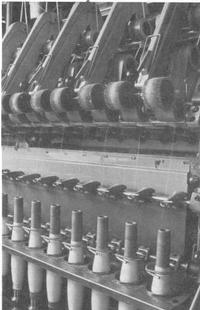


Chapter 5
I 1788 - State Of The Art In Textile Technology
II Australian Textiles - The Early Days
i Wool Fabric Manufacture
ii Cotton and Flax
iii The 19th Century - Automation Accelerated in Textile Technology
III Australian Textiles - The 20th Century
IV Australian Textiles - To Date
V Acknowledgements
References
Index
Search
Help
Contact us

The 19th Century - Automation Accelerated in Textile Technology (continued)
The third, and in the long term the most important, combing development of this period was the comb developed by Heilmann in France. The principles developed by Heilmann are essentially those used today on machines for both cotton and wool, although initially they were predominantly used for cotton and for short wools.The machine was based on an intermittent rather than continuous action and had low production. It was mechanically designed for short fibres and had a very good cleaning action. It was consequently suitable for shorter length wools which were in general associated with higher levels of contamination than the longer more valuable 'fleece' wools.
The major advance in spinning in the 19th Century was undoubtedly the introduction of the ring spindle (Fig. 11). Developed in the U.S.A. in 1832, this is still by far the most widely used system of spinning, despite very significant advances over the past 20 years. The spindle (Fig. 12) rotates at high speed (nowadays capable of speeds up to 25,000 r.p.m.). It passes up through a ring set in a rail, which moves up and down to lay the yarn evenly on the bobbin mounted on the spindle. Over the flange of the ring is sprung a C-shaped wire, called the traveller, and a thread guide is set overhead exactly in line with the axis of the spindle.


In setting up the machine, the thread from the drafting rollers is led through the thread guide down to the traveller and under it to the bobbin. When the spindle revolves, the traveller is pulled around the ring by the yarn, which is attached to the bobbin, and puts in one turn of twist for each revolution. Centrifugal forces make the yarn balloon out in motion, and the consequent air resistance causes the traveller to rotate at a slightly slower speed than the spindle. In this way the yarn is wound on.
 |
Australian Academy of Technological Sciences and Engineering |  |
© 1988 Print Edition pages 269 - 270, Online Edition 2000
Published by Australian Science and Technology Heritage Centre, using the Web Academic Resource Publisher
http://www.austehc.unimelb.edu.au/tia/278.html